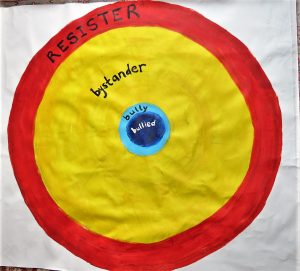The Bully, The Bullied, and the ‘not so innocent’ Bystander
In October’s blog about Bullying, we shared that research has shown that students who have a disability are more worried about school safety and or being injured or harassed by their peers than students without disabilities (pacer.org). The title of this blog is the title of a book from Barbara Coloroso, an international author and speaker on child/youth issues. (www.kidsareworthit.com) She talks about the three roles that are involved in bullying.
· Bully: The one who is doing the unfair, unkind, unjust, mean behavior.
· Bullied: The one being harmed, mistreated, unfairly or unjustly treated, ridiculed.
· Bystander: The one who sees or observes another being bullied. Those that watch, laugh, pretend not to see, but are aware of the bullying.
Barbara Coloroso refers to this group as ‘the not so innocent’ Bystander and she believes this group has a lot of potential for helping make our communities and individuals safer. She states if bystanders see or hear or are made aware of bullying happening then have a role to play. Bystanders are needed to bring justice and healing to the situation.
The Bystander Effect refers to the phenomenon in which the greater the number of people present, the less likely people are to help a person being treated unfairly. Bystanders often don’t intervene because they don’t know what to do, they don’t want to make things worse. They don’t want to be physically harmed or they don’t feel like they have enough information.
So what can Bystanders do? There are plenty of actions we can take that are safe and that are helpful. Hollaback is an online organization that addresses sexual harassment and give five things that we can do as bystanders. www.ihollaback.com
They emphasize that there is more than one choice and refer to these choices as the 5D’s.
· Distract- take an indirect approach to de-escalate the situation. Drop coins, our phones, ask the one being bullied for directions.
· Delegate- Go get some help. Preferrable from an authority figure but also can ask other bystanders to help.
· Document- use you phone to record, or simply take notes on paper about where you are and what you are witnessing. If we record situation, have to be very careful where we share that and get the one being bullied permission.
· Delay- follow up the with one who was bullied after the event/situation. Make sure they are ok. Let them know what happened was not ok and wasn’t their fault.
· Direct- intervene with words: Stop, leave them alone, Go away. Once we’ve used our words to directly interfere, our attention needs to go to the one being bullied.
When ‘not so innocent’ Bystanders understand they have a role to play in bringing justice and fairness to a situation and chose to safely intervene, Barbara Coloroso calls them: Resisters. We can all learn the skills to safely be a Resister if we observe bullying and help make the world a safer place for all.


